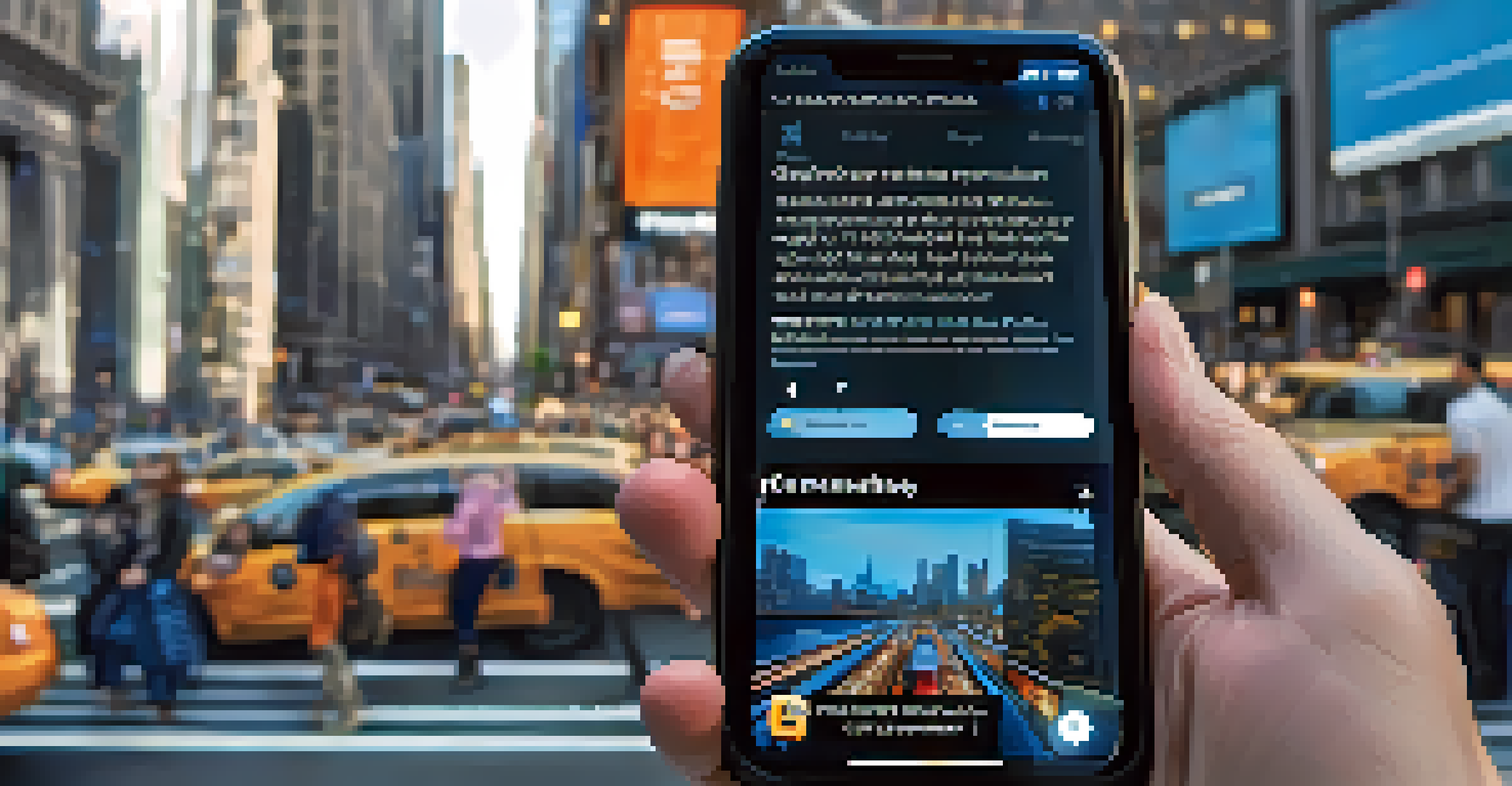Role of Social Media in NYC's Crisis Communication Strategy

Understanding Crisis Communication in New York City
Crisis communication is crucial for any city, but in a bustling metropolis like New York City, it takes on an even greater significance. When emergencies arise, timely and accurate information can save lives and maintain public trust. NYC's approach to crisis communication integrates traditional methods with modern technology to ensure residents are informed swiftly and effectively.
In the midst of chaos, there is also opportunity.
In recent years, the importance of social media has surged, becoming an essential tool for disseminating information quickly. Whether it's a natural disaster or a public health crisis, platforms like Twitter, Facebook, and Instagram help city officials reach a broad audience almost instantaneously. This shift towards digital communication reflects a growing recognition of where people get their news and updates.
Moreover, social media allows for two-way communication, enabling citizens to ask questions and share information in real time. This interactivity fosters a sense of community and collaboration, essential during times of crisis. By leveraging these platforms, NYC can not only inform but also engage its residents, building a more resilient community.
The Role of Twitter in Real-Time Updates
Twitter has become a primary channel for real-time updates during crises in NYC. With its character limit and fast-paced nature, officials can share concise, critical information that reaches followers in seconds. During events like Hurricane Sandy, NYC's official Twitter accounts provided continuous updates on emergency services, shelter locations, and safety tips.

This immediacy is vital in a city where every second counts. For instance, when a subway service is disrupted due to a flood, an immediate tweet can inform commuters of alternative routes or delays. This quick dissemination of information not only helps manage the situation but also reduces panic among residents.
Social Media Enhances Crisis Response
NYC effectively uses social media platforms like Twitter and Facebook to provide real-time updates and engage with residents during emergencies.
Additionally, Twitter's trending feature allows important messages to gain visibility beyond just followers. As users retweet and share updates, crucial information can spread rapidly, reaching even those who might not be actively following official accounts. This organic sharing amplifies the city's communication efforts, making it an indispensable tool during emergencies.
Leveraging Facebook for Community Engagement
While Twitter excels in real-time updates, Facebook plays a different yet complementary role in NYC's crisis communication strategy. With its longer format, Facebook allows officials to provide detailed updates, share stories, and foster community discussions. This platform is particularly effective for sharing comprehensive safety information and resources during a crisis.
The greatest weapon against stress is our ability to choose one thought over another.
For example, during the COVID-19 pandemic, NYC utilized Facebook to host virtual town halls and Q&A sessions. These forums allowed residents to voice concerns, ask questions, and receive direct responses from city officials, making them feel heard and informed. This level of engagement is vital for building trust and facilitating a collaborative response.
Moreover, Facebook's event feature has been instrumental in organizing community support efforts during crises. From blood drives to volunteer opportunities, the platform connects residents eager to help with those in need. This sense of community involvement is essential in overcoming challenges together.
Instagram for Visual Storytelling in Crisis
In a visually driven world, Instagram serves as a powerful platform for storytelling during crises. NYC utilizes this platform to share images and videos that communicate the emotional and human aspects of emergencies. For example, during protests or public health campaigns, compelling visuals can drive home the urgency of the situation.
Additionally, Instagram Stories offer a unique way for officials to share updates in a more casual, approachable manner. These ephemeral posts can provide quick tips, highlight community initiatives, or share behind-the-scenes efforts during a crisis, making information more relatable. This helps to humanize the messages being delivered.
Consistency Builds Trust in Communication
Maintaining consistent messaging across various channels is crucial for NYC to ensure credibility and reduce confusion during crises.
Furthermore, the platform's use of hashtags can help gather and disseminate information quickly. By creating specific hashtags for emergencies, NYC can encourage citizens to share their experiences and information, fostering a community-driven response to crises. This collective effort can enhance awareness and support during difficult times.
The Importance of Consistent Messaging
In times of crisis, consistency is key when it comes to communication. NYC understands that conflicting messages can lead to confusion and mistrust among residents. Thus, ensuring that all social media content aligns with official statements and updates is essential for maintaining credibility.
To achieve this, city officials often coordinate their messaging across various platforms. A tweet might echo a Facebook post, ensuring that the same information reaches audiences where they are most active. This unified approach helps to create a clear narrative, which is critical when misinformation can spread just as quickly as accurate information.
Moreover, consistent messaging reinforces the city’s authority and reliability as a source of information. When residents recognize that they can trust official channels, they are more likely to follow guidance and stay informed during emergencies. This trust is vital for effective crisis management and community resilience.
Training Officials for Effective Social Media Use
To harness the full potential of social media for crisis communication, NYC invests in training for its officials. Understanding how to craft messages that resonate with diverse audiences is essential in today’s digital landscape. Training includes best practices for writing clear, concise updates and engaging with the public effectively.
Additionally, officials learn to navigate the unique challenges that social media presents, such as managing negative comments or misinformation. This training prepares them to respond promptly and professionally, which is crucial during high-stress situations. By equipping officials with these skills, NYC enhances its overall crisis communication strategy.
Training Officials for Digital Proficiency
Investing in social media training for city officials equips them to communicate effectively and manage misinformation during high-stress situations.
Furthermore, ongoing education about emerging trends and tools keeps city officials ahead of the curve. As social media platforms evolve, so too must the strategies employed to utilize them effectively. This proactive approach ensures that NYC remains prepared to communicate effectively, no matter the crisis.
Challenges of Social Media in Crisis Communication
While social media offers numerous advantages in crisis communication, it also presents challenges that NYC must navigate. One significant issue is the rapid spread of misinformation, which can lead to confusion and panic among residents. False information can circulate just as quickly as accurate updates, making it imperative for officials to monitor and address inaccuracies promptly.
Additionally, the sheer volume of information shared on social media can overwhelm both officials and citizens. During a crisis, the flood of updates can make it difficult for residents to discern what is relevant and trustworthy. NYC must find ways to cut through the noise and deliver clear, actionable information that residents can rely on.

Moreover, not all demographics engage with social media equally. While younger populations may be active on platforms like Instagram, older generations might prefer traditional forms of communication. This disparity means that NYC must continue to use a multi-channel approach, ensuring that all residents have access to critical information, regardless of their preferred communication method.
Looking Ahead: The Future of Crisis Communication
As technology continues to advance, the role of social media in crisis communication will only grow. NYC is committed to adapting its strategies to incorporate new tools and platforms that emerge. This includes exploring features like live streaming for real-time updates or leveraging data analytics to gauge public sentiment during crises.
Additionally, as more residents turn to social media for information, NYC must remain vigilant in combating misinformation. Investing in digital literacy campaigns can empower citizens to understand how to identify credible sources and avoid falling prey to false narratives. This proactive approach will strengthen the community's resilience in the face of crises.
Ultimately, NYC's crisis communication strategy will evolve alongside the social media landscape. By embracing innovation while prioritizing clear and consistent messaging, the city can continue to foster trust and engagement among its residents. This commitment to effective communication will be vital in navigating future challenges.